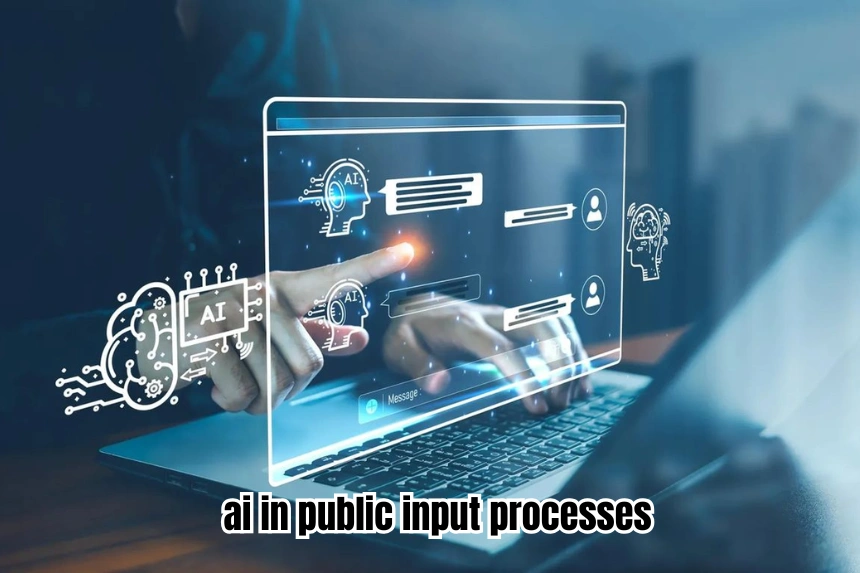Introduction
Public participation has always been a cornerstone of democratic governance. From town hall meetings to online surveys, governments and organizations rely on citizen feedback to shape policies, infrastructure, and community development. However, traditional public input processes often face challenges—low participation rates, accessibility barriers, data overload, and the difficulty of analyzing diverse perspectives effectively.
This is where AI in public input processes enters the picture. Artificial Intelligence isn’t just a technological buzzword anymore; it is redefining how public voices are gathered, understood, and applied to decision-making. By leveraging AI, governments, NGOs, and community organizations can streamline feedback collection, identify meaningful patterns, and ensure that a broader range of voices is heard.
Why AI Matters in Public Input Processes
AI has the unique ability to handle vast amounts of unstructured data—something public administrators have struggled with for decades. Citizen input often comes in the form of long comments, discussions, or fragmented suggestions, making it difficult to analyze manually. AI tools can process this information rapidly, classify it into themes, and even detect sentiment, giving decision-makers a clearer picture of community priorities.
The use of AI in public input processes also brings scalability. A single platform powered by AI can collect and analyze feedback from thousands—or even millions—of people without the need for enormous human resources. This creates a level playing field where all voices, regardless of scale, can contribute meaningfully to shaping policies.
Key Benefits of AI in Public Input Processes
1. Enhanced Accessibility and Inclusion
AI-driven platforms can offer multilingual support, voice-to-text capabilities, and even adaptive interfaces for people with disabilities. This ensures that participation is not limited by language, literacy, or mobility barriers. For example, natural language processing (NLP) can automatically translate citizen comments, allowing policymakers to include feedback from non-native speakers.
2. Data-Driven Insights
Instead of manually reading thousands of responses, administrators can rely on AI to detect trends, measure public sentiment, and highlight recurring concerns. Machine learning models can surface hidden insights that human reviewers might overlook, making policymaking more data-informed.
3. Reduced Bias in Analysis
Human interpretation of public feedback often comes with unconscious biases. AI tools, when properly designed and trained, can help reduce subjective distortions by providing neutral, pattern-based summaries of input. This makes the process more transparent and trustworthy.
4. Real-Time Feedback Processing
AI can analyze incoming feedback instantly, enabling decision-makers to respond faster. For example, during public consultations on urban planning, city councils can monitor ongoing sentiment in real time and adjust communication strategies accordingly.
5. Cost Efficiency
Automating analysis reduces the need for large teams of analysts and saves time. This efficiency allows governments and organizations to allocate resources more effectively toward implementation rather than just data processing.
Practical Applications of AI in Public Input Processes
Urban Planning and Smart Cities
Cities around the world are using AI to engage citizens in infrastructure planning. For example, residents might provide feedback about traffic congestion, and AI tools can cluster this data to identify hotspots and recommend solutions.
Policy Development and Regulation
When drafting new regulations, governments often open public comment periods. AI can categorize the thousands of submissions received, identifying recurring concerns such as environmental impact, safety, or economic costs.
Community Engagement in Health Initiatives
During the COVID-19 pandemic, AI-powered platforms analyzed community feedback on safety measures, vaccination campaigns, and digital healthcare tools. This helped public health authorities tailor their messaging and address concerns quickly.
Environmental and Climate Projects
AI assists in analyzing public feedback on issues such as renewable energy projects, conservation efforts, or waste management. By summarizing diverse viewpoints, it ensures that environmental policies reflect the voices of affected communities.
Challenges and Ethical Considerations
While the benefits are significant, the use of AI in public input processes also raises concerns that must be carefully addressed.
Data Privacy and Security
Public input often involves sensitive data. Ensuring that AI platforms comply with strict data protection laws (such as GDPR) is critical to maintaining public trust.
Algorithmic Bias
AI models are only as good as the data they are trained on. If biased data is fed into the system, the outcomes may reinforce inequalities. Transparent model design and independent audits are essential.
Over-Reliance on Automation
While AI can analyze data efficiently, human judgment remains crucial. Policymakers must avoid over-reliance on AI outputs and continue to validate findings with expert and community perspectives.
Digital Divide
Not everyone has equal access to digital platforms. Ensuring offline participation channels remain available is important for inclusivity.
The Future of AI in Public Input Processes
As AI technology evolves, its role in civic participation will likely expand. Future trends may include:
AI-Powered Chatbots for Engagement – Citizens could interact with government chatbots to share feedback, ask questions, and receive updates instantly.
Predictive Analysis – AI could forecast community reactions to proposed policies, helping decision-makers anticipate concerns before implementation.
Interactive Virtual Forums – Combining AI with virtual reality could create immersive public consultation sessions where people experience policy impacts before giving feedback.
Transparency Dashboards – AI-driven dashboards may provide real-time summaries of public input, showing citizens how their feedback is shaping policy.
Conclusion: Toward Smarter, More Inclusive Governance
The integration of AI in public input processes represents a turning point in civic engagement. By making participation more inclusive, feedback analysis more accurate, and policymaking more transparent, AI empowers both citizens and leaders to collaborate effectively.
However, technology alone cannot solve all challenges. Responsible implementation, ethical safeguards, and continued human oversight are essential to ensure that AI enhances—rather than replaces—the democratic process.
Ultimately, the success of AI in public participation will depend on a simple principle: using technology not just to process voices, but to genuinely listen to them.


